PowerLabs NitroStarch Synthesis
INTRODUCTION:
Nitro starch, is actually a mixture of several nitrate esters of starch with the formula [C6H7(OH)x(ONO2)y]n where x+y=3 and n is any whole number from one on up. The exact composition depends on the reaction conditions during the nitration. Nitrostarch found a use as a filler in hand grenades back in WWII, and also in mining explosives It was first made when H. Barconnot nitrated cellulose and starch back in 1833. At that time nitrocellulose and nitrostarch were thought to be one and the same. Then A. B�champ applied various methods of separating them in 1862. The US first began to produce nitrostarch in 1888 under the name Volney Powder. Various companies produced nitrostarch throughout both world wars, but the US emerged as its sole manufacturer.
It was after being enquired by a British Chemist as to the manufacture of this compound that I realized that the Internet did not yet have a source of information as to how its synthesis may be performed. Knowing the similarities between it and nitrocellulose, and having performed the synthesis of nitrocellulose numerous times before, it was realized that nitro starch could be made in a similar way, and so experiments were performed to find out exactly how. The first batches suffered from nitration runaway, excess un-nitrated starch, and decomposition during acid neutralization. After 5 failed attempts which included anything from dumping the reaction halfway to having to evacuate the room to flee a cloud of billowing nitrogen dioxide vapor, a somewhat effective procedure was devised, which is shown below for informational purposes.
As with any other nitration, this procedure is hazardous and involves the use of highly corrosive acids. The final product is toxic and dangerous. This should only be attempted by experienced chemists!
MATERIALS:
|
Reactants: |
Glassware: |
|
150mL Glass beaker. |
|
|
Pipette |
|
|
Stirring Rod |
|
|
Funnel/filter paper |
|
|
Ice bath |
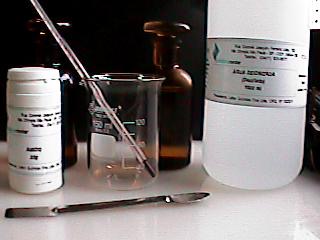 Here all the chemicals used in the synthesis are seen, from left to right, back to front: Sulphuric Acid (98%), Nitric Acid (68%), Distilled water, corn starch, 150mL pyrex beaker, thermometer, spatula.
Here all the chemicals used in the synthesis are seen, from left to right, back to front: Sulphuric Acid (98%), Nitric Acid (68%), Distilled water, corn starch, 150mL pyrex beaker, thermometer, spatula.
PROCEDURE:
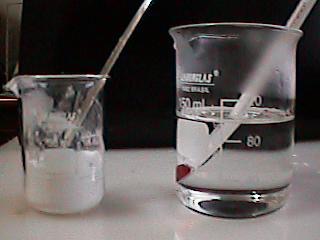 A solution of 65mL Sulphuric Acid (98%) and 35mL Nitric Acid (68%) are mixed in a 150mL beaker and allowed to cool (the dehydration of the nitric acid produces enough heat to warm the solution by as much as 60C, so it is very important to start off with the acids at no more than room temperature, and to cool the mixture down to 10C or so prior to the addition of starch.
A solution of 65mL Sulphuric Acid (98%) and 35mL Nitric Acid (68%) are mixed in a 150mL beaker and allowed to cool (the dehydration of the nitric acid produces enough heat to warm the solution by as much as 60C, so it is very important to start off with the acids at no more than room temperature, and to cool the mixture down to 10C or so prior to the addition of starch.
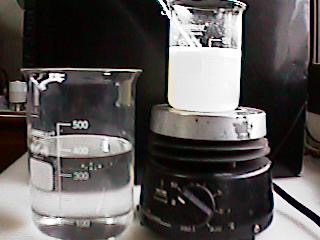 Starch is than added slowly whilst the mixture is stirred vigorously until all of the 18cc have dissolved. During the addition the temperature rises and it is important that it does not go above 35C. Once all of the starch has dissolved the mixture is placed on a hot plate and heated to 40C for one and a half hours, with occasional stirring. It forms into a white precipitate with a consistency similar to honey.
Starch is than added slowly whilst the mixture is stirred vigorously until all of the 18cc have dissolved. During the addition the temperature rises and it is important that it does not go above 35C. Once all of the starch has dissolved the mixture is placed on a hot plate and heated to 40C for one and a half hours, with occasional stirring. It forms into a white precipitate with a consistency similar to honey.
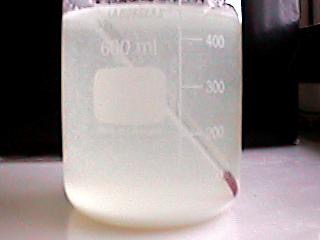 Once the heating period is complete the nitro starch and acids mixture are added to 400mL of cold distilled water and stirred. Once stirring stops the nitro starch can be seen precipitating in the bottom of the beaker. As with nitrocellulose, the nitrated version of starch looks no different from what was started out with. Filtering this acid solution presents a special problem, however: It will weaken the filter paper and cause it to rip. Attempting to neutralize it with a carbonate will require very large amounts of it and cause everything to foam out of the beaker. Neutralizing it with ammonium hydroxide causes it to boil over and decomposes the nitrate. My solution was to use a micropore nylon filter which was not attacked by the acid, and filter the solution through it, with considerable loss of the final product. Decantation might prove worthwhile if one is willing to wait the long time required for all of the nitro starch to precipitate at the bottom.
Once the heating period is complete the nitro starch and acids mixture are added to 400mL of cold distilled water and stirred. Once stirring stops the nitro starch can be seen precipitating in the bottom of the beaker. As with nitrocellulose, the nitrated version of starch looks no different from what was started out with. Filtering this acid solution presents a special problem, however: It will weaken the filter paper and cause it to rip. Attempting to neutralize it with a carbonate will require very large amounts of it and cause everything to foam out of the beaker. Neutralizing it with ammonium hydroxide causes it to boil over and decomposes the nitrate. My solution was to use a micropore nylon filter which was not attacked by the acid, and filter the solution through it, with considerable loss of the final product. Decantation might prove worthwhile if one is willing to wait the long time required for all of the nitro starch to precipitate at the bottom.
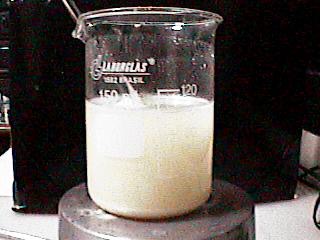 The final product of any nitration will always contain some residual acid and oxides of nitrogen which can make it extremely unstable and prone to self decomposition when stored over time. It is thus necessary to neutralize this acidity. The industrial method calls for washing with Ammonium Hydroxide solution, however I found that my nitro starch decomposed when treated that way. I decided to boil it in sodium bicarbonate solution instead, and add some Urea to the final product so as to take up any nitrogen oxides produced (this is essentially what is done to nitrocellulose).
The final product of any nitration will always contain some residual acid and oxides of nitrogen which can make it extremely unstable and prone to self decomposition when stored over time. It is thus necessary to neutralize this acidity. The industrial method calls for washing with Ammonium Hydroxide solution, however I found that my nitro starch decomposed when treated that way. I decided to boil it in sodium bicarbonate solution instead, and add some Urea to the final product so as to take up any nitrogen oxides produced (this is essentially what is done to nitrocellulose).
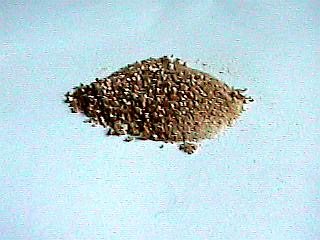 Here you see the final product, after 5 failed attempts. It consists in a fine powder that is mostly white but due to some decomposition during the acid neutralization phase (it seems as though nitro starch is highly temperature sensitive) acquired a brownish tint. It dissolves in acetone much in the same way nitrocellulose does.
Here you see the final product, after 5 failed attempts. It consists in a fine powder that is mostly white but due to some decomposition during the acid neutralization phase (it seems as though nitro starch is highly temperature sensitive) acquired a brownish tint. It dissolves in acetone much in the same way nitrocellulose does.
RESULTS!
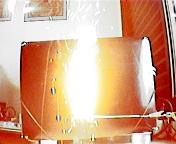 The product deflagrates with a very hot flame in exactly the same way as nitrocellulose, as can be seen on the picture to the left. Clicking on the picture will show a video of this particular burn test (146kb). It was concluded that nitrocellulose is a much more worthwhile starting product for nitrations.
The product deflagrates with a very hot flame in exactly the same way as nitrocellulose, as can be seen on the picture to the left. Clicking on the picture will show a video of this particular burn test (146kb). It was concluded that nitrocellulose is a much more worthwhile starting product for nitrations.
Please Donate to PowerLabs so I can continue to fund more experiments!
© 2022 Copyright by Sam Barros. All rights reserved.
Removing any material from this site for display without consent from its author consists in an infringement of international copyright laws and can result in fines up to $50000 plus legal costs per infringement.

